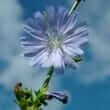Background
- Chicory is native to Europe and temperate regions in Asia; it has been naturalized to the United States. Chicory was cultivated as early as 5,000 years ago by Egyptians as a medicinal plant. Traditionally, chicory juice was used as part of a remedy for headaches. The Romans used chicory as a vegetable or in salads. The root was ground and used as a caffeine-free coffee substitute.
- Chicory is still an important salad vegetable in Europe, especially in France, Belgium, and Holland. In the United States, chicory is also grown as a salad green. Preliminary study has investigated chicory for chronic hepatitis; however, at this time there are no high-quality human trials supporting chicory for any indication.
References
Natural Standard developed the above evidence-based information based on a thorough systematic review of the available scientific articles. For comprehensive information about alternative and complementary therapies on the professional level, go to . Selected references are listed below.
- Abrams SA, Griffin IJ, Hawthorne KM, et al. A combination of prebiotic short- and long-chain inulin-type fructans enhances calcium absorption and bone mineralization in young adolescents. Am J Clin Nutr 2005;82(2):471-476.
View Abstract - Ahmed B, Al Howiriny TA, Siddiqui AB. Antihepatotoxic activity of seeds of Cichorium intybus. J Ethnopharmacol 2003;87(2-3):237-240.
View Abstract - Bischoff TA, Kelley CJ, Karchesy Y, et al. Antimalarial activity of lactucin and lactucopicrin: sesquiterpene lactones isolated from Cichorium intybus L. J Ethnopharmacol 2004;95(2-3):455-457.
View Abstract - Bornet FR, Brouns F, Tashiro Y, et al. Nutritional aspects of short-chain fructooligosaccharides: natural occurrence, chemistry, physiology and health implications. Dig Liver Dis 2002;34 Suppl 2:S111-S120.
View Abstract - Cadot P, Kochuyt AM, van Ree R, et al. Oral allergy syndrome to chicory associated with birch pollen allergy. Int Arch Allergy Immunol 2003;131(1):19-24.
View Abstract - Cavin C, Delannoy M, Malnoe A, et al. Inhibition of the expression and activity of cyclooxygenase-2 by chicory extract. Biochem Biophys Res Commun 2005;327(3):742-749.
View Abstract - Debarbieux-Deleporte M, Delbreil B, Collin T, et al. InsP(3)-mediated calcium release induced by heterologous expression of total chicory Leaf RNA. Biol Cell 2002;94(7-8):545-552.
View Abstract - Delzenne NM, Cani PD, Daubioul C, et al. Impact of inulin and oligofructose on gastrointestinal peptides. Br J Nutr 2005;93 Suppl 1:S157-S161.
View Abstract - Esiyok D, Otles S, Akcicek E. Herbs as a food source in Turkey. Asian Pac J Cancer Prev 2004;5(3):334-339.
View Abstract - Grieshop CM, Flickinger EA, Bruce KJ, et al. Gastrointestinal and immunological responses of senior dogs to chicory and mannan-oligosaccharides. Arch Anim Nutr 2004;58(6):483-493.
View Abstract - Hazra B, Sarkar R, Bhattacharyya S, et al. Tumour inhibitory activity of chicory root extract against Ehrlich ascites carcinoma in mice. Fitoterapia 2002;73(7-8):730-733.
View Abstract - Johannsen FR. Toxicological profile of carboxymethyl inulin. Food Chem Toxicol 2003;41(1):49-59.
View Abstract - Petrovic J, Stanojkovic A, Comic L, et al. Antibacterial activity of Cichorium intybus. Fitoterapia 2004;75(7-8):737-739.
View Abstract - Pool-Zobel BL. Inulin-type fructans and reduction in colon cancer risk: review of experimental and human data. Br J Nutr 2005;93 Suppl 1:S73-S90.
View Abstract - Sakurai N, Iizuka T, Nakayama S, et al. [Vasorelaxant activity of caffeic acid derivatives from Cichorium intybus and Equisetum arvense]. Yakugaku Zasshi 2003;123(7):593-598.
View Abstract







